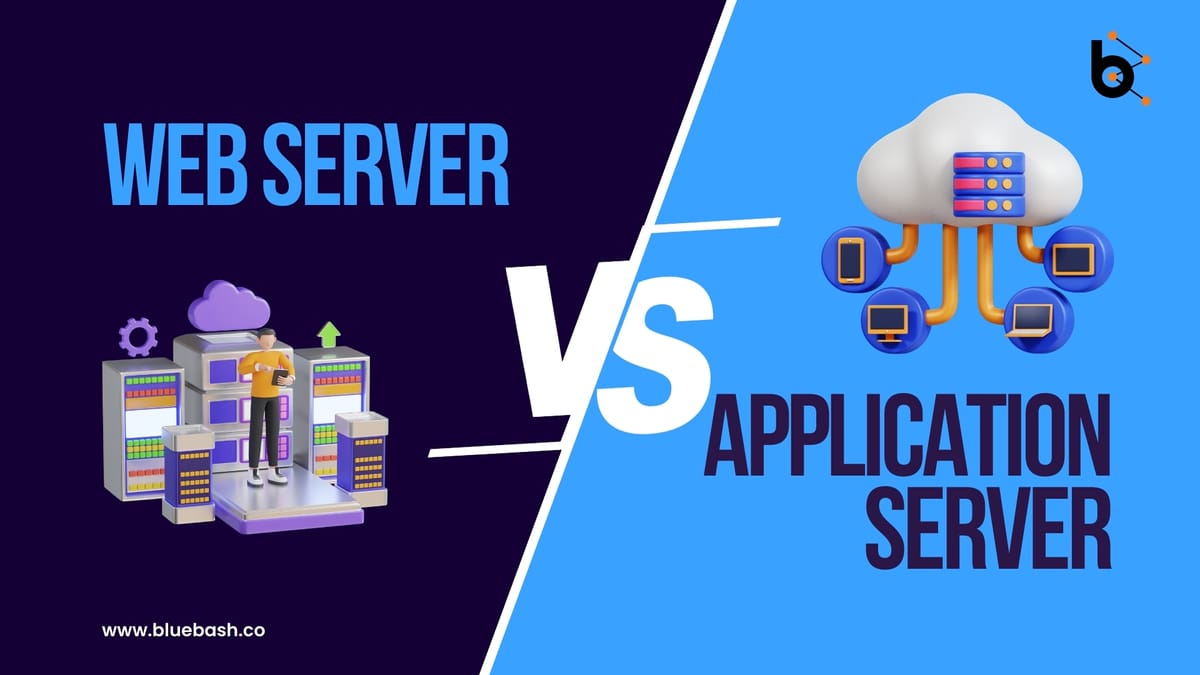Web Server vs Application Server: A Comprehensive Comparison

In the world of web development, terms like "web server" and "application server" often come up, especially when you're deploying applications. While both play critical roles in delivering a smooth user experience, they serve distinct functions within the web architecture. Let's delve into what each one does, their differences, and how they work together to bring web applications to life.
What is a Web Server?
A web server is responsible for handling HTTP requests from clients (such as web browsers) and delivering web content. When you enter a URL in your browser, the web server processes this request retrieves the requested resource (like an HTML, image, Javascript file, or CSS file), and sends it back to the client's browser.
Examples: Common web servers include Nginx and Apache.
Key Functions of a Web Server:
- Static Content Delivery: Web servers serve static content quickly and efficiently, HTML files, CSS, JavaScript, and images.
- HTTP Request Handling: They process incoming HTTP requests and responses, understanding various HTTP methods such as GET, POST, PUT, and DELETE.
- SSL/TLS Management: Web servers handle secure connections using SSL/TLS to encrypt data transmitted between the server and client.
- Load Balancing: Some web servers distribute incoming traffic across multiple servers to prevent any single server from being overwhelmed.
- Caching: Web servers can cache static content, reducing the server load and speeding up response times for users.
What is an Application Server?
An application server is a specialized software framework that runs your web applications and keeps them ready to handle incoming requests. It executes dynamic content and handles business logic. When a web server receives a request involving more than serving static files (such as database queries, user authentication, or dynamic page generation), it forwards this request to an application server and the app server handles all the business logic and data retrieval from the database and then hands over the response back to a web server which then shows the result to the client (user).
Examples: Application servers include Unicorn, Puma, and Phusion Passenger for Ruby on Rails applications, and Tomcat for Java applications.

Key Functions of an Application Server:
- Loading and Managing Code: The application server initializes your Rails application's code and dependencies into memory, ensuring readiness to handle requests efficiently without repeated loading.
- Maintaining State: By keeping the application in memory, the server maintains state between requests, enabling session management and authentication.
- Request Handling: It processes dynamic requests from the web server by executing application logic, interacting with databases, and generating dynamic responses.
- Concurrency Management: Designed to handle multiple concurrent requests, the application server manages multiple instances or threads, ensuring smooth performance for multiple users.
- Middleware Integration: Supports middleware for tasks like authentication, logging, and API management, enhancing request and response handling before reaching the application or returning to the web server.
- Response Generation: Generates appropriate responses, such as HTML pages or JSON data, after processing requests, and sends them back to the web server.
- Error Handling and Logging: Manages and logs errors during request processing, providing developers with insights to ensure application stability and reliability.
How Web Servers and Application Servers Work Together
In a typical web application architecture, web servers and application servers collaborate to handle client requests efficiently:
- Initial Request Handling: When a client makes a request, it first hits the web server. If the request is for a static resource, the web server handles it directly.
- Forwarding Dynamic Requests: The web server forwards dynamic content requests to the application server.
- Processing by Application Server: The application server processes the request, interacts with databases, and executes the necessary business logic.
- Generating Response: After processing, the application server generates a response (such as an HTML page with user-specific data) and sends it back to the web server.
- Final Delivery: The web server delivers this response to the client’s browser.
Conclusion:
Understanding the roles of application servers and web servers helps simplify the complex world of web development. By categorizing software into these buckets, we gain clarity and insight into the complex workings of our digital infrastructure. With this clarity, troubleshooting server issues becomes easier. Knowing where to look and how things work together makes problem-solving smoother. Plus, when new application servers come along, we're better equipped to integrate them easily into our setup.
Let's embark on a journey of deep comprehension. It's not just about overcoming obstacles, it's about embracing the thrill of innovation and discovery in the ever-evolving world of web development.
Faqs-
What is the primary difference between a web server and an application server?
A web server handles HTTP requests and serves static content such as HTML, CSS, and JavaScript files. Application servers provide dynamic content, such as tailored information, real-time updates, and customer service.
Can a single server act as both a web server and an application server?
Yes, some server technologies, such as Apache Tomcat, can function as both a web server and an application server. However, for larger applications, it is common to separate these roles for better performance and scalability.
Why do we need a web server if we have an application server?
A web server is optimized for handling HTTP requests and serving static content quickly and efficiently. It is also capable of handling load balancing and SSL/TLS encryption. An application server is specialized in executing application logic and handling dynamic content, which is typically more resource-intensive.
What are some popular web servers and application servers?
Popular web servers include Nginx and Apache. Common application servers include Unicorn, Puma, and Phusion Passenger for Ruby on Rails applications, as well as Tomcat for Java applications.
How do web servers handle secure connections?
Web servers manage secure connections using SSL/TLS protocols, which encrypt data transmitted between the client and the server to ensure privacy and data integrity.



